By Raymond Lamontagne
Peter has kicked off the 2019 blogging campaign in style, with an intriguing comparison of wine preservation methods that will make a significant contribution to the annals of Pop & Pour science. And me? Well, I’m back doing one of the things I do most frequently on this blog: covering a tasting. This one was a casual drop-in scenario, bypassing the formal sit-down presentation, and on this date that was just fine by me. The frigid weather has left me irascible and more than a little crabby. Fortunately, we’ve got a prescription for those blues… and its not more cowbell. It is glorious, glorious Burgundy.
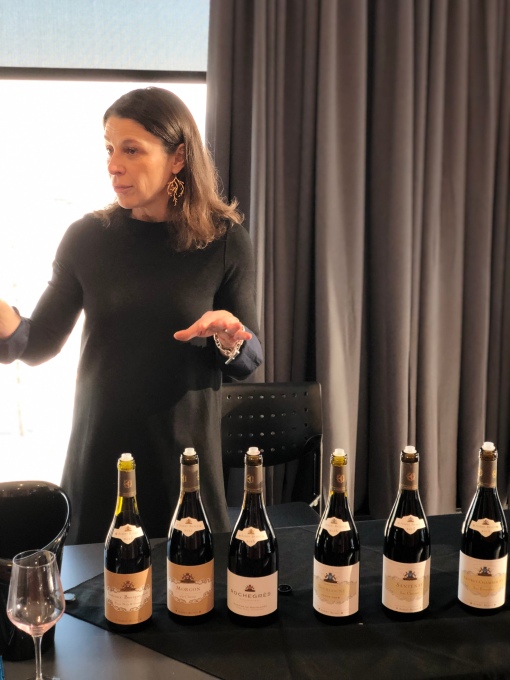
I’ve mentioned my love affair with Burgundy (and Pinot Noir more generally) enough times on PnP, so I won’t belabour the point here. I had not tried any wines from Albert Bichot before, but I was promptly faced with 15 (!) of them, in a carefully curated sequence of whites and reds, from Chablis to Grand Cru, complete with a bonus round detour into Beaujolais Cru territory. Fifteen! I was titillated and daunted in approximately equal measure. How the hell is a guy supposed to keep these all straight, what with the small pours, limited analysis time, and numerous distractions around the table? I like to meditate on a half-bottle or more, savouring and seeing how the wine develops over time, as one’s palate habituates to the initial impressions. This is another kettle of fish entirely, with a pace more like Whac-A-Mole than a game of chess, although I do have my tricks, particularly a powerful secret weapon: “Beginner’s mind”. This is an application of mindfulness, where one deliberately pays attention to the present moment, concentrating the attention into a laser beam focused only on the wine in the glass, and then seeing what associations are dredged up. With beginner’s mind, you explicitly adopt a form of make-believe in which you imagine that the liquid in the glass is foreign, entirely novel, never before encountered, and see what this clean slate provides. Might sound hokey, but give it a try during a tasting. It’s like a palate cleanser for the brain. All this aside, I will not take much credit for the fact that I WAS ultimately able to keep all these wines distinct in my mind’s eye. This was more testament to the artistry of the 6th generation producer Domaines Albert Bichot.

As our delightful hostess explained, Domaines Albert Bichot is a negociant who takes the produce of smaller growers and winemakers and sells the results under its own name. This produce can include whole grapes, grape must, and even finished wines. What perhaps sets Albert Bichot apart, however, is a particularly tenacious focus on preserving terroir. Rather than employing a single “flying winemaker” who works across the numerous regions and subregions that fall within Albert Bichot’s purview, a dedicated winemaking team is assembled for each region. These winemakers intimately know their own grapes and the land on which they grow. This means that regional variation is preserved across the Bichot portfolio, instead of a scenario where the unified vision of a single winemaker leads to relative homogeneity. I will also mention that I appreciated the candour during this tasting. Albert Bichot has been transparent about their journey from high volume producer to one focused on greater quality. There is no need to blow smoke. I applaud their efforts. Let’s see how they are doing on this quest, at least by one man’s reckoning.
Chablis
We begin with Burgundy’s northernmost outpost, home of cold temperatures, turbulent weather, and crystalline, ethereal Chardonnay that is often more mineral than fruit. The grapes for Bichot’s entry level Chablis Villages are carefully sourced from throughout the appellation. This wine sees only stainless steel during vinification, followed by 10 months aging on the lees. It is hard to believe that only the second wine of a 15-wine assemblage is a Chablis Grand Cru, but it would be ludicrous to complain. This one hails from a 2.6 ha plot in the heart of the region, “Les Vaudesirs”, which features south-facing exposures and calcareous/clay soils known to yield pronounced minerality. It is vinified in 75% steel and 25% 1 to 5 year-old oak barrels, followed by 10 months on the lees. One heck of a start.
- Albert Bichot Chablis 2017 (~$39): An initial impression of lemon-lime soda (Sprite) on the nose, followed by stark, stony minerals on the palate. Green apple/pear, hints of nectarine. Taut acidity. A preliminary “blocky” impression resolves into something far more precise. 89+ points
- Albert Bichot Chablis Grand Cru Les Vaudesirs Domaine Long Depaquit 2015 (~$ 103): Even more stark, stony minerals, this time accompanied by white peach, Asian pear, yellow apple, pumpkin, golden kiwi, and a generous dose of pungent lemon and yellow grapefruit rind. A faint whiff of butter. White stones (flint, quartz) in lockstep with bold fruits, including the ghost of something tropical. It is the minerals that carry the resplendently long finish, though. 92 points
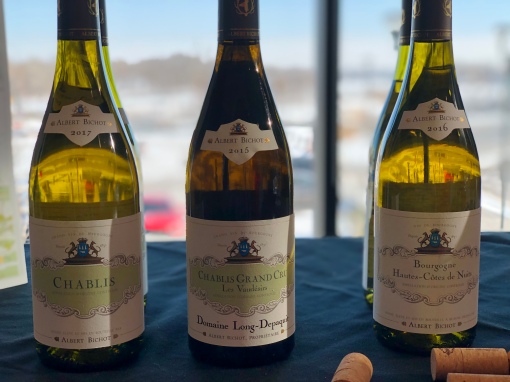
The Other Whites of Burgundy
This sundry heading does not appropriately capture the magnitude of the fact that I am about to describe a Grand Cru. Regardless, we begin with a Hautes-Cotes De Nuits, which refers to an area located on a plateau behind the far more famous region, essentially west of the village of Nuits-Saint-Georges. Grapes ripen more slowly in this often cold, harsh terrain, but this also means more pronounced acidity and a corresponding freshness. Still, this temperamental produce requires a deft hand on the winemaking rudder. The present wine is of course 100% Chardonnay, and is both made and aged (8 to 12 months) in 80% steel tanks and only 20% oak. The Beaune Premier Cru vineyard “Clos des Mouches” is named after the numerous beehives in the area, and here we have something regal that sees barrel fermentation (50% new oak) plus aging (25% new). As for the Corton-Charlemagne? Suffice to say, this terroir can yield some of the finest white wine in the world. Although Pinot Noir does grow here, Chardonnay gets the best sites on the highest slopes. Bichot’s white masterpiece sees handpicked grapes fermented and aged for 12 to 15 months in oak (30% new).
- Albert Bichot Bourgogne Hautes-Cotes De Nuits 2016 (~$35): Seems to represent a nigh-perfect bridge between Chablis and the next wine. Sturdy minerality, more green apple and pear, lemon and tangerine rind, low-key white flowers, faint starfruit and hay. Just one elegant notch past workmanlike. 88+ points
- Albert Bichot Beaune Premier Cru Clos des Mouches Domaine du Pavillon 2016 (~$158): Nose quite closed initially but there’s no mistaking the provenance. Eventually white flowers blossom, followed by acacia, lemon and lime zests, green banana, and a dusting of fine brown sugar and wet sand. Sculpted, racy acidity. 92 points
- Albert Bichot Corton-Charlemagne Grand Cru 2016 (~$244): Silky smooth but with a lovely push-pull tension; just enough of a rustic edge to amp up the complexity, but not enough to spoil the elegance. White and yellow peach, ripe yellow pear, starfruit, vanilla pudding, modelling clay, coconut water. Zippy and zesty, yet paradoxically rich and round. Fun out on the town, but you can also bring her home to the parents. Why I sometimes love white Burgundy almost as much as the red stuff. 93 points
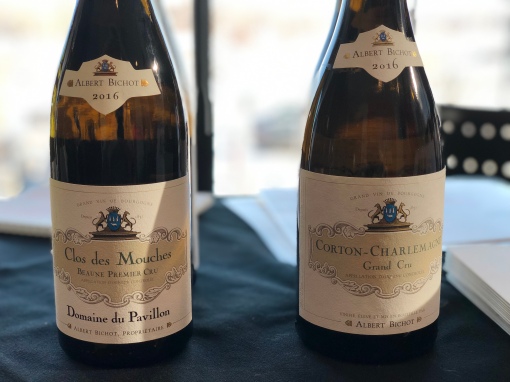
Beaujolais Crus… And A Recent Appellation
If we are going to detour from Burgundy for a moment, I will not balk if we land in Beaujolais. The latter is actually a southern extension of Burgundy, but few associate the two in this fashion. I drink Burgundy when I feel like taking myself seriously (which is apparently quite often), and Beaujolais when I want to cut loose. I do love Morgon, a red wine that often features a peachy note. This was the only full-on purple wine at this tasting, an outlier in an ocean of ruby. Moulin-a-Vent is named after a windmill but is not inclined to whimsical tilting. This Cru is more structured than the stereotypical Beaujolais and can take on a positively Pinot-like cast with age. Both of these wines are vinified in temperature-controlled open tanks and aged in a mixture of 350L barrels and vats for 10 to 12 months. Finally, we get a fun introduction to the relatively recent appellation of Coteaux Bourguignons. Created in 2011, this officially allows Gamay into a Burgundy wine, either as a varietal or (as in this case) blended with Pinot Noir. This wine sees just a little oak, only during the 7 to 8 month aging process. I might just be cutting loose more often…
- Albert Bichot Morgon “Les Charmes” 2017 (~$29): Makes a profound impression of spicy cardamom, coriander seed, and incense that nearly outpaces the black cherry fruit, at least on the nose. Yup, there it is, a little white peach. Subtle notes of graphite. Decent body, but it is the spicy aroma that most impresses. 89 points
- Albert Bichot Rochegres Moulin-A-Vent Domaine de Rochegres 2016 (~$67): Huge wafts of campfire smoke and lilacs, followed by thick, rich red fruits (raspberry, strawberry, red cherry). Some graphite mid-palate, and a middling finish of redcurrant and MacIntosh apple. The smokiest wine in attendance. 89+points
- Albert Bichot Coteaux Bourguignons 2015 (~$22): Nose almost port-like (?!) right out of the gate, but this calms down to yield fresh rose (petals and hips), boisterous tart cranberries and cherry hard candy with strawberry playing second fiddle. Bright, glowing acidity. Slightly rustic Kool-aid, in all the best ways. 88+ points
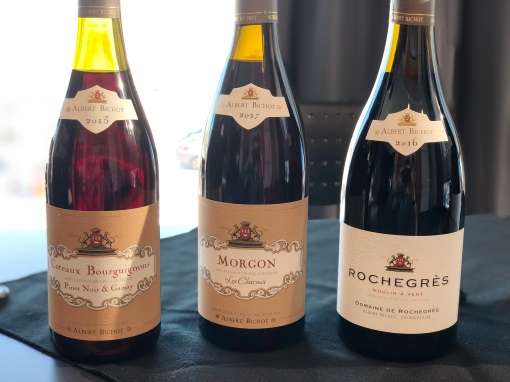
Red Burgundies: Village and Premier Crus
You still reading? Of course you are. I reach the meaty part of the tasting in rather good spirits. We charge through an entry-level “old-vines” Burgundy whose grapes hail from both the Cote de Beaune and the Cote de Nuits to reach a rather unique offering from the southernmost part of the Cote de Beaune, Santenay, which sees fermentation in temperature-controlled oak vats followed by 14 to 16 months in barrel. This Santenay is a curious wine, so smoky and meaty, almost like a Syrah, but it is at this point that I have to work hard to control my impatience. I have to consciously stop myself from peeking ahead to the Grand Crus. Besides, I adore Gevrey-Chambertain, even at the village level. Ideally these wines are sumptuous, to quote Clive Coates: full, firm, and rich, with a “masculine” concentration. A few sites do yield softer wines. The present wine hails from grapes across the region and sees fermentation in the aforementioned oak vats followed by 14 to 16 months in barrels (15 to 25% new). Finally, we get a premier cru from the mighty Vosne-Romanee. To again quote Clive Coates, this is “the greatest Pinot village on Earth”, home to some of the most expensive wines in the world. These are known to be rich yet rather austere, masculine, and aristocratic. Bichot owns 1.75 ha of the “Les Malconsorts” Premier Cru, a positively bitchin’ French phrase that means “bad partners”. The name is apparently a reference to an ownership dispute. The vineyard site is a mere few hundred metres away from the legendary Romanee-Conti and Richebourg sites! All right, you really do have my attention.
- Albert Bichot Bourgogne Rouge 2016 (~$22): “Classic” nose of strawberry, lavender, and thyme with accents of red chilli pods and darker fruits (Saskatoons). Fresh acid bite that recalls rhubarb but without the obvious associated aromas. Sip or crush, dealer’s choice. 88+ points
- Albert Bichot Santenay Les Charmes 2015 (~$49): The return of the smoke…this is rather burly, beefy, meaty with a bit of a bite. Pomegranates and cherry tomatoes dusted with charcoal and woody stems. Could use more fruit on those broad shoulders, but interesting nonetheless. 87+ points
- Albert Bichot Gevrey-Chambertin “Les Evocelles” 2015 (~$100): Elegant, lithe, and less masculine than expected. Crystalline raspberry and strawberry fruit with a subtle toasty undercurrent. Wafts of vanilla and liquorice All-Sorts. Very fine tannins. 91+ points
- Albert Bichot Vosne Romanee Premier Cru “Les Malconsorts” Domaine Du Clos Frantin 2016 (~$244): Now we get the sumptuous. Plush red and black cherries abound. Subtle undercurrent of herbs growing in the woods: rosemary, catnip, and cedar. Tannins are pliant and round but with a little scratch that I find works to balance the lush cherry fruit. Deft, tasteful hand on the oaky rudder. Let this one cellar; 10 years would not be out of line. Brilliant. 92+ points
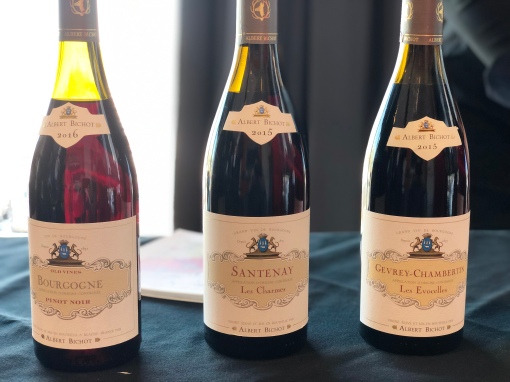
Red Burgundies: Grand Crus
Here. We. GO. We begin in Echezeaux, one of the larger Grand Crus generally known for correspondingly variable terroir and wines can can skew toward the earthy and rustic, even if they do remain formidable in their own right. In this case the grapes hail from a single plot on a particularly steep slope. Clos de la Roche is a classy Grand Cru in Morey, falling on a gentle incline that yields good drainage. These wines are lush, exotic, and hedonistic. Clive Coates refuses to describe them as “dignified”. Finally, we have Charmes Chambertain. This is another gentle slope, this time in Gevrey-Chambertain, characterized by iron-laden rocks and wines described as “direct and forward” yet delicately fragrant when at their best. All these grand crus were fermented in temperature-controlled oak vessels followed by 14 to 16 months aging in barrels, with 50-70% new wood. Without further ado…
- Albert Bichot Echezeaux Grand Cru Domaine Clos Frantin 2015 (~$316): The same winemakers who brought us the Vosne Romanee Premier Cru described above (although the “du” is missing here from the Clos description, it seems) knock another one out of the park. Although probably the most overtly tannic of the wines sampled here, this is still a bit of a greyhound, not lacking finesse despite some burnished rusticity throughout. Strawberry, raspberry, and pomegranate core meets spearmint, incense, clove, and tamarind. A palpable heat kicks off the immensely long finish. 92+ points
- Albert Bichot Clos de la Roche Grand Cru 2016 (~$364): Raspberry is the dominant fruit, but wait for the cavalcade of darker brambles (blackberry, loganberry), bilberry/blueberry, ripe tomatoes, blood orange, and slight hits of dried earth and leaves, truffle, coffee, and celery salt. There is a sublime tension between the more chewy elements and other facets that skew things toward a deft precision. If rubies were edible, they might taste like this. Another for the cellar. 94 points
- Albert Bichot Charmes Chambertin Grand Cru 2015 (~$302): Another that makes a bright, plush fruit impression; predominantly red cherries and red and black plums, but with whacky hints of candied apple and Laffy Taffy. A bit heavy, sapid, but ultimately in balance, with a wreath of sorrel and damp earth to remind one that this is not COMPLETELY light-natured. Something tells me that this could get more feral with time. 94 points
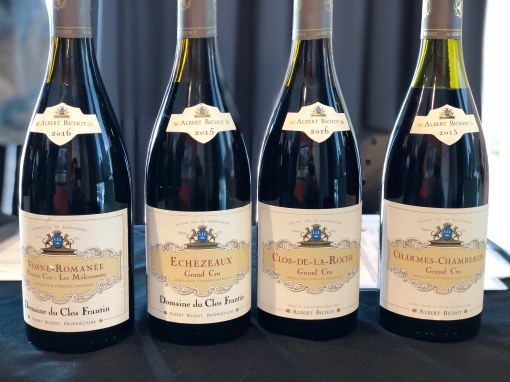
The final verdict? Burgundy lovers on any budget can find something of interest across this spectrum. It is surprising to encounter so few bum notes across 15 wines from such wildly divergent sites and price points. I hope this monograph does them justice.


Well done coverage Raymond with your detailed tasting notes on 15 different Burgundy wines of Albert Bichot from the current vintages. Interesting article by you. I attended a trade tasting of the same wines in Vancouver with Delphine on February 7. My posting from a different angle at blog.iwfs.org.
LikeLike
Thank you Sid! And thanks for sharing the link with our readers!
LikeLike